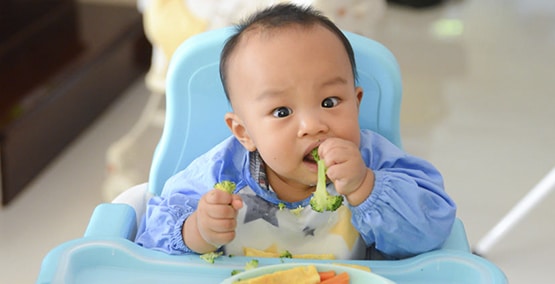Baby led weaning: Using table foods to teach babies to chew
Establishing self feeding for first solid foods
-What is Baby Led Weaning (BLW)?
Usually initiated around 6 months of age, baby led weaning is a technique intended to improve the development of oral motor control. This is to complement the baby's current feeding method of either formula or breastmilk and does not replace them. Table foods instead replace baby foods and are slowly introduced. A balanced, table-food meal with fruits and plenty of vegetables offer more nutrients and challenge babies to develop their learned patterns of tongue lateralization, tongue elevation and munching and chewing. These oral motor skills cannot be learned with baby-food, since thin, pureed foods require little more than sucking.
Some parents often use this approach without thinking about it. This is especially common with busy parents with other children. Parents may offer their baby the same food as the rest of their family in small pieces on the tray of their high chair and this is essentially baby led weaning.

The BLW method encourages babies to self-feed, which allows for better control of the solids. At first, it may look like these infants are playing with their food. They smell, lick or suck on their food, but it is experimentation. When they can interact with their food in this manner and have control, it makes for a more pleasant and positive experience for them. BLW advocates feel that babies who have fun at mealtime, rather than being forced to consume certain foods, will be less likely to have anxiety or aversion issues down the road, though that has not been proven.
When Can We Start?
Healthcare professionals suggest babies begin introduction of solids around 6 months of age, when the digestive system matures and babies can swallow and digest foods with greater ease.
What Are The Best Foods to Start?
| 6-8 Months | Introduce soft, peeled Fruits and soft, cooked Vegetables. Fruits and vegetables should be served plain, NOT in mixed dishes. Good Examples are: green peas, potatoes, carrots, sweet potatoes, squash, beans, beats, bananas, applesauce, apricots, pears, peaches and melon. Serving Size: 2-3 tablespoons, 4 times/dayIntroduce 1 at a time, with 2-3 days between introductionsPreparation: Cut fruits and vegetables into small, bite-sized piecesCooking methods for vegetables: steamed, or baked until softAvoid: Hard or uncooked fruits and vegetables, for example apple chunks/slices, or grapesOther allowed foods: Iron-Fortified Instant Cereals, Graham Crackers, Melba Toast, Noodles and Teething Biscuits Noodles should be bite-sized or cut into small piecesAvoid: salty and sugary snacks, due to the fact that early consumption of these additives enhances preference for these foods |
| 8-12 Months | Introduction of finely chopped and cooked Meats and Rich Protein Sources. Good examples are: beans and legumesBreastfed babies are encouraged to begin at 8 months, because breastmilk is not a rich source of iron, which is required by the infant body.Introduce 1 meat/week in 3-4 tablespoon servingsCooking methods: meat should be fully-cooked (bake, braise, roast, pan-fry) and simmer beans in water. Fully-Cooked Egg YOLK (not the whites) can be consumed by the child 3-4 times/weekIncrease servings of Fruits and Vegetables to 3-4 tablespoons, 4 times/day. |
| 1 Year | Whole Milk can replace breastmilk or formula, however, low-fat milk is NOT recommended before age 2. Egg Whites are safe for your baby to eat now. |
| CAUTION | REMEMBER: Because of the risk of choking, avoid foods with skins or hard foods. Some examples of these hazardous foods include: Hotdogs, Peanut Butter, Nuts, Seeds, Popcorn, Round Candies, Hard Chunks of Uncooked or Raw Vegetables, Raisins, Whole Grapes, Uncut Stringy Meats, and Sticky-Foods Honey should be avoided because of the risk of a dangerous infection in infants. |
Is There Any Danger?
Not every baby tolerates BLW well. If your baby has any motor delays, these may also affect their ability to chew and use their tongue well. They may also have difficulty swallowing. And even otherwise healthy infants may have some oral motor problems. So it's important to stay with the baby and watch for any signs of gagging or choking.
Even the allowed foods should be cut into small, bite-sized pieces. And you should avoid any foods that still have their skins on, like apples or grapes; any food that might be too firm (A well-cooked carrot would be reasonable, but not one that is raw or barely cooked.

